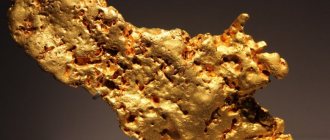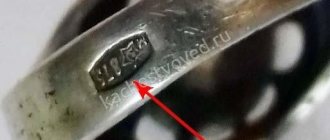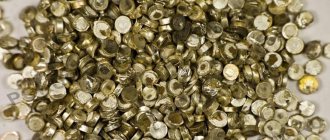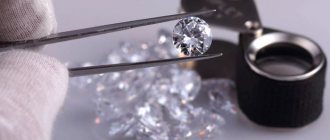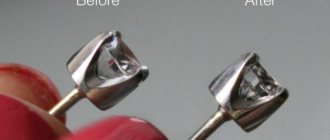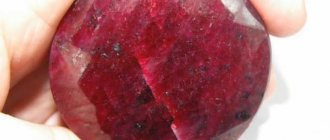Hello, dear reader! Today I will not tell the fascinating story of the discovery and use of this amazing noble metal. It is enough that now it is an expensive and sought-after raw material for the manufacture of jewelry. Although its popularity has recently been growing rapidly, many do not really know what platinum looks like, and therefore the risk of encountering a counterfeit increases, for example, in online stores, and not only in them.
I will tell you how to determine platinum so as not to become a victim of scammers.
How to choose the right platinum
Platinum today is an expensive precious metal that is widely used in jewelry. It has external similarities with white gold and silver. Silver can often be passed off as platinum. Especially if you buy metal secondhand. It is advisable to make such purchases in trusted jewelry stores. But you shouldn’t let your guard down there either. It is almost impossible to visually distinguish platinum from a fake, but there are some nuances that you should definitely pay attention to.
Due to the high cost of metal, jewelry made from it is rarely massive. Most likely, these are neat, miniature products. Also pay attention to the ability to heat up. Try warming the jewelry in your palms for a few minutes. If it does not take your body temperature, then you are dealing with the original.
Be sure to look at the presence of the sample (850, 900, 950, 999) and at the data indicated on the tag or in the so-called product passport. Under no circumstances agree to purchase jewelry without these attributes.
How to check the authenticity of platinum at home
Platinum has a pure white luster that is unlike any other metal. Silver of even the highest standard will have a grayish tint.
Do you think it is necessary to distinguish platinum yourself? Here are several ways to test platinum.
Ammonia or ammonia
Ammonia is easy to obtain at any pharmacy. Ammonia will not react with metal, unlike others that leave dark stains. If no reaction occurs, you are the happy owner of a real jewel.
Iodine
Contact with iodine will cause a dark spot to appear on the platinum. It can be easily removed immediately after the experiment. The darker the color of the spot, the higher the grade of the metal.
Salt
Salt will also come to the rescue if you need to check the authenticity of the jewelry. This experiment will require a little work. You will need:
- can;
- batteries;
- salt and water solution.
Pour the solution into a jar and place the decoration in it. The plus batteries must be connected to the product, and the minus batteries must be connected to the jar. If sediment forms and the liquid becomes cloudy, you are dealing with a fake. If the water remains clear, everything is fine. If you smell chlorine, don't be alarmed. This is the result of the reaction. You have the original in your hands.
Magnet
This method is the least effective, but also has a right to life. Like other noble metals, platinum is not attracted to magnets. This will protect you from crude counterfeiting, but it will not be possible to distinguish silver from platinum in this way.
How to distinguish platinum from other metals
From silver
The most common item given out under the guise of an expensive metal is silver. Here are a few criteria to consider when choosing platinum jewelry that will help determine the authenticity of the platinum.
- Hue. The original will always be lighter and whiter than silver. If your platinum jewelry has darkened over time, it is most likely sterling silver.
- Silver is much lighter. Their weight varies significantly. Jewelry of the same size will always weigh differently.
- Density. This indicator for white metal is one of the highest among others, so it is not susceptible to almost any mechanical influence.
- Temperature resistance. Platinum is much more resistant to high temperatures. For example, if you bring it to an open fire, nothing will happen to it. Silver heats up very quickly and takes on ambient temperature. This can be checked by even holding the product under hot water for several minutes.
How to distinguish platinum from white gold
Less often, white gold is given out under the guise of an expensive metal. An important difference, which unfortunately cannot be checked when purchasing, is that white gold is an alloy of several metals. As a rule, these are nickel, palladium, silver and yellow gold itself.
In the case of white gold, one of the elements added to it can cause allergies. Platinum, unlike white gold, does not cause allergies.
Again, don't forget to make sure you have a sample. The fineness values for platinum and white gold are different. For gold it is 500, 585, 750, and for white metal it is 850, 900, 950.
Gold is easily subject to mechanical stress. It is easy to scratch or leave marks on it. Platinum has a very high density, so this shouldn’t happen to it.
The weight, as in the case of silver, is very different. Platinum is much heavier.
White gold, although it has this name, still has different shades. This occurs due to the presence of certain elements in the alloy. Platinum jewelry always has a noble white tint. The only shade very similar to precious metal is the rhodium plating. It shines beautifully and also has a white undertone, which makes it almost impossible to visually distinguish it from its more expensive relative. However, over time, this coating begins to wear off and needs to be renewed.
The difference is also in cost. Products made from premium metal will never cost less than white gold.
From stainless steel
Stainless steel is very difficult to distinguish. In the question of how to determine platinum, methods that work for other metals will not help. Pay attention to the price. Steel will cost much less. There will be no markings on steel, while platinum jewelry will always have one.
Otherwise, it is possible to distinguish stainless steel from platinum only in the laboratory by taking physical measurements.
All that glitters is not gold
Only a jeweler who has all the necessary analytical equipment can check a gold item and issue a reliable conclusion as to whether it belongs to a noble metal. Professional verification is carried out by the Assay Chamber. Examination of gold jewelry is not a cheap pleasure; the price of the service ranges from 10 to 20% of the estimated value of the item. Gold is being counterfeited more and more often, and no one wants to waste money. By the way, the need to check gold for authenticity may arise not only in relation to jewelry, but also, for example, when purchasing bars or nuggets.
Silver earrings with cubic zirconia, SL; (price on the link)
The most difficult type of counterfeit to independently identify gold is a piece of jewelry on which a thin layer of precious metal is applied. It is extremely difficult to determine the authenticity of such work at home without causing damage to the product.
The most common methods of counterfeiting gold items:
- surface gilding;
- replacement with copper;
- alloys of aluminum and other metals;
- an alloy of titanium and gold.
Fake jewelry made from alloys similar in color to gold leave spots on the skin with a green tint, especially when the ring is worn for a long time. The substitution of less valuable metal alloys for gold by others or similar deposition can be determined using well-known methods.
The first stage is checking gold by comparison. Surely you have a piece of jewelry whose authenticity you have no doubt about. A line should be drawn on a hard object with these two decorations. Gold items will leave the same mark, but if there are differences, this is a direct reason to doubt the quality.
Using a magnifying glass, look closely at the mark, which should reflect the gold standard. It should be clear and without damage.
The cost of a gram of gold changes daily, however, you should rely on it when purchasing jewelry, even if it is not purchased in a store.
Gold ring with diamonds and citrines, SL; gold earrings with diamonds and citrines, SL; (price on the link)
There is also an opinion that sound helps to identify a copy. Gold items emit a crystal ringing sound when they hit a hard surface. A dull or any other sound is a cause for concern.
Iodine test
Iodine can change the color of most components that are used to falsify precious metal, but this test is completely harmless for jewelry with a purity above 500 (i.e., which contains more than 50 mass percent gold).
A drop of pharmaceutical alcohol solution of iodine should be applied to the product that is in doubt, and after 10-15 seconds, remove its remains with a napkin. If a trace of iodine remains, then this is not a gold product. Unaltered metal color may indicate authenticity.
Magnet check
Precious metals are not affected by magnets. Steel products coated with a thin layer of gold will instantly be attracted to the surface of a magnet; real gold jewelry will not react to a magnet.
Many manufacturers use lock designs for chains and bracelets that include a steel spring - in this case, the magnet will only attract the lock.
Indifference to a magnet is a necessary condition, but not a sufficient one. For example, most alloys of copper and tin are non-magnetic. However, such products are much lighter: the difference in weight can be felt even without an analytical balance.
Vinegar test
A cheap fake will turn black when exposed to acetic acid. If you put gold with a purity above 500 into it, then nothing will happen to it. This is another surefire method of recognizing authenticity. 3-5 minutes is enough to conduct the experiment.
By the tooth
You've probably seen in films how the main characters tried a gold coin "by tooth." This method is only suitable for high-grade gold (whiter than 900), which is relatively soft. On such gold, teeth marks will definitely remain, since its hardness is much lower than that of other metals.
Determining the authenticity of gold using analytical instruments
Instant identification of metal components at home is possible using a special device called a metal analyzer. The result is displayed on the screen within 2-3 seconds. To obtain it, you need to point the device at the object under study. The analyzer is widely used by precious metal miners.
Gold earrings with diamonds and sapphires, SL; (price on the link)
In order not to doubt the authenticity of gold jewelry, you should choose the right place to purchase it. Jewelry stores and pawn shops are selling points for real precious metals. Buying second hand is always a risk.
Platinum as a catalyst
This expensive metal, in addition to jewelry, has a very wide range of applications in other areas. For example, in technical applications it is used as a catalyst. It produces nitric acid. Platinum catalysts accelerate many chemical reactions, which is why it is also used in the production of sulfuric acid. In 1821, a chemist from Germany discovered the property of platinum catalysts to accelerate the process of converting wine alcohol into wine vinegar without exposure to high temperatures. At the same time, he noted that nothing happens to the metal itself. He also found out that a mixture of oxygen and hydrogen, when interacting with platinum black or platinum sponge, causes combustion. And due to the active release of heat, an explosion occurs. Thus, he invented a means of making fire before matches were invented.
The world's first platinum catalyst was produced in the 60s of the last century. It was a dehydrogenation catalyst.
Platinum is also used as a catalyst in other industries. This:
- Oil refining industry, where it is also used as a catalyst;
- Electrical engineering sector of production. It is used for the production of various sensors, electrical appliances, contacts, devices where high precision is required;
- Automotive industry. In this case, platinum is used as a catalyst;
- Space industry. Electrodes of fuel cells in spacecraft are manufactured
- Medicine. All surgical interventions are performed with platinum instruments; metal is also used in dentistry, cardiology, and for the manufacture of prosthetic parts
- Glass. Metal is used to produce high-quality optical devices. They also produce fiberglass and equipment for the production of premium quality glass.
- Chemical instruments.
How to extract platinum from a catalyst
Many resourceful people, knowing about the great value of the metal, know how to extract platinum from a catalyst and use it. Most often, platinum catalyst can be found in the automotive industry. It is from such a catalyst that the precious metal is most often extracted. An auto component filled with ceramics or metal looks like a honeycomb, and its upper part is coated with precious metal. It could be platinum, rhodium or palladium. This is necessary in order to reduce the level of toxic substances released during vehicle operation.
Resourceful people, knowing about this deposition, use auto catalysts to extract the noble metal. To extract tolls, two methods are used:
- leaching;
- "aqua regia"
The leaching method is most often used. To carry it out you will need nitric and hydrochloric acids. Due to the fact that the auto catalyst is made of ceramic or aluminum, this complicates the leaching process, since the ceramic or metal reacts with acids and oxidizes. This results in the loss of some platinum. Therefore, this method requires several catalysts.
First, the catalyst is soaked in a solution of hydrochloric acid. Then it is heated and, when vapor appears, oxidizing agents are applied.
Comparison
Externally, these metals are similar: both are white, only platinum is slightly darker. They differ radically in density: one cubic centimeter of silver weighs 10.5 grams, and platinum weighs more than 21 grams, that is, twice as much! The melting point of silver is 962 degrees Celsius, and platinum is 1768 degrees, that is, again, almost twice as much. Silver has been known as a material for jewelry for a very long time, but platinum began to be used for this purpose only in the 19th century.
Nowadays, the areas where both metals are used overlap in many ways. This is, first of all, the jewelry industry. In addition, both silver and platinum are used for minting investment coins and in creating medals and orders: for example, the profile of Lenin on the Soviet Order of Lenin is made of platinum. The cost of precious metals can fluctuate greatly depending on market conditions, but the cost ratio remains approximately the same: platinum is almost sixty times more expensive than silver. Now it is approximately 1856 and 33 rubles per gram.
The low oxidability of these noble metals has helped them find a large “sector of responsibility” in a number of technical industries. Silver and platinum alloys are used for soldering electrical contacts in contact with aggressive environments, including in the space industry. The refractoriness and durability of platinum allows it to be used in the chemical industry - for the manufacture of crucibles and laboratory glassware. The technical specialization of silver and platinum is quite extensive. Among the most common (besides the above), it is worth mentioning dentistry (platinum and silver crowns) and the food industry: silver is well known as a food additive E 174.
